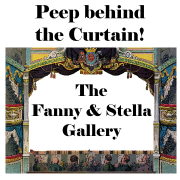 Neil McKenna’s book revisits one of Victorian Britain’s most explosive trials.
Neil McKenna’s book revisits one of Victorian Britain’s most explosive trials.
The Charge of Personating Women
Yesterday afternoon the Bow-street Police-court and its approaches were literally besieged by the public, owing to the re-examination of the two young men, Ernest Boulton aged 22 of 43, Shirland-road, Paddington, and Frederick William Park, aged 23, of 13, Bruton-street, Berkeley-square, under remand upon the charge of wearing women’s clothes, at the Strand Theatre … for a supposed felonious purpose.
The prisoners appeared in male apparel on this occasion, much to the disappointment, apparently, of the crowds assembled to see them. The case excited unusual interest, probably owing to the notoriety acquired by certain young men who, for years past, have been in the habit of visiting places of public resort in female attire, and who have occasionally been turned out or compelled to retire to avoid the consequences of the public indignation excited by their presence when detected.
The Times, Saturday 7 May 1870
McKenna presents less a social history, more a biography of Fanny and Stella – young men with “respectable” professions (both clerks, in stockbroking and law) who played female roles on and off stage. They did so with little regard for “common decency” at a time when the sexual and moral hygiene of the bourgeoisie mattered deeply to the British authorities, who needed them to uphold domestic industry and the Empire it supported.
Fanny and Stella mixed with male and female sex workers in London’s “seedy” sexual underworld, generally not being made welcome by either group. At the same time, Stella presented herself as the wife of former Liberal MP Lord Arthur Clinton, part of an aristocracy seen as increasingly corrosive. Stella in particular was a well-known entertainer who profited from the craze for farces and melodramas, and was regarded as a genuine beauty; the rise of mass media and printed photographs carried the “sensational” images of her and Fanny to a world never previously would have encountered them.
Organisations such as the Society of the Suppression of Vice believed London to be the new Sodom; after the Metropolitan Police was established in 1829, its officers began to patrol the boundaries of gender and sexuality, bringing men who dressed as women to court, usually charged with soliciting or public order offences. Mostly, defendants claimed this behaviour to be “a lark” and escaped with a fine, but as details emerged about Fanny and Stella’s lives, it became clear that theirs was no individual aberration. It seemed, explosively, that a cross-class sodomite ring was about to be broken.
The vital new factor was the Metropolitan Police’s decision to subject Fanny and Stella to a medical examination, conducted by Dr Paul, to find out if they had engaged in anal sex. Although McKenna provides less than authors such as H G Cocks on how this trial differed from those that preceded it, he is strong on the cultural and legal history of sodomy, and especially on the absurdities of Victorian attempts to establish scientific criteria for it. This is often tragi-comic: one of Dr Paul’s authorities claimed that “the dimensions of the penis of active pederasts were excessive in one way or another” and “pointed and moulded to the funnel shape of the passive anus”.
This transgression soon became public knowledge, through the Daily Telegraph and The Times’ extensive reporting (although McKenna neglects that the Pall Mall Gazette, for one, refused to cover the story for fear of corrupting readers through its very mention). One reason that it took a year to bring Fanny and Stella to court was that their lawyers immediately contested Dr Paul, conducting counter-examinations that found no evidence of same-sex activity. As the charges shifted from “unnatural offences” to “conspiracy”, it became clear that Fanny and Stella’s gender and sexuality – indeed, their entire being – were on trial, rather than any specific incident: as McKenna skilfully points out, convicting them for thought rather than deed would have set a highly dangerous (not to mention unworkable) precedent.
McKenna tells us that “Their life was a performance’ with ‘London [as] their stage”, with Bow Street court as the biggest show of all. With little more evidence than an underwhelming set of camp letters, the prosecution focused on how frequently Boulton dressed as Stella, assuming gender variance and sexual diversity to be inherently linked, and whether or not s/he tried to deceive men into sex through this feminine presentation. To the disappointment of the baying crowds, the defendants took the dock in suits, as prosecution witnesses explained that they knew about Fanny and Stella’s birth sex, and “begged” Boulton to grow a moustache and give up drag, or “swing their arms more” so they appeared more masculine.
The defence emphasised Fanny and Stella’s youthful “foolishness”, extending the “lark” cliché into the suggestion that they were engaged in some sort of proto-performance art or method acting. ‘Drag’ had a long tradition, and Fanny and Stella merely took their (widely recognised) theatrical personas into the wider world. Gradually, opinion turned towards them: Mary Ann Boulton, Stella’s mother, offered testimony that normalised her son’s behaviour, but more importantly, it emerged that the Metropolitan Police had tracked them for years, with Dr Paul already primed to examine them, and a key witness speaking of “getting up evidence”. There was a conspiracy, it appeared: against Fanny and Stella.
The refusal to openly discuss sodomy made it impossible to convict Fanny and Stella – for the court to do so would have meant admitting that it understood the innuendo in the letters. It would also implicate the aristocracy, through Lord Clinton. McKenna convincingly contests Clinton’s apparent death of scarlet fever in June 1870, speculating that, knowing too much about the proclivities of the upper classes, may have absconded (under pressure or not). With this in mind, the defence argued that a guilty verdict would shame the nation – a tactic successfully repeated in Manchester when 24 men were tried for their part in a drag ball in 1880.
Tantalisingly, magistrate Mr Flowers said after Fanny and Stella’s first court appearance that “I was in hopes that the defence would be that they were women”. It is tempting to consider how this might have worked: as the judge lamented in summing up, grudgingly conceding that Fanny and Stella could not be convicted, there were no specific laws against cross-dressing. Had the question of how “man” and “woman” were defined been raised in such a loaded forum at this time, the history of gender and sexuality may have looked very different.
More on this summing up would have been interesting: the judge said that Fanny and Stella’s gender was “an outrage upon public decency” and “not to be tolerated even when it is done as a mere frolic and amusement; it … deserves summary and severe punishment … And if the law as it is cannot reach it, then it ought to be the subject of legislation.” Clearly, the acquittal infuriated powerful elements of Victorian society, and fed into Labouchere’s amendment to the Criminal Law Amendment Act 1885, which made “gross indecency”, even between consenting men in private, a crime.
McKenna takes 19th century social conservatism as read, but offers some fascinating insights into Fanny and Stella’s place as outsiders not just in “respectable” society, but also within the underworld to which their gender non-conformity led them. Without delineating gender variance and sexual diversity (something which came with 20th century sexology) or transposing modern terms onto the Victorian era, McKenna evokes the differences between Fanny and her brother Harry, who had sex with men without dressing in “female attire”. The author respects Fanny and Stella’s gender presentations, using female pronouns as default, and engages well with the language of their time: occasionally this makes Fanny & Stella feel a little over-written, but the affection of McKenna for his subjects, his comprehensive knowledge of Victorian sexuality and the quality of his research easily outweighs this.
The postscript is fascinating, showing how certain players in Fanny and Stella’s trial were implicated in the Dublin Castle affair of 1884 and the Cleveland Street scandal of 1889, both of which raised concerns about how the aristocracy corrupted the working classes, as Britain’s imperial campaigns in Africa required ever greater numbers. Meanwhile, Fanny fell to syphilis – an epidemic which ravaged the Victorian queer subculture, and which the press and politicians preferred not to discuss. So too did Stella, but not before she had gone to New York, rebranded herself as Ernest Byne and re-established herself as a glamorous drag star: until her end in 1904, outliving Queen Victoria by two years, Stella refused to bow to moral convention and created her own rules of gender.
(Published in NewStatesman, 18 March 2013)






